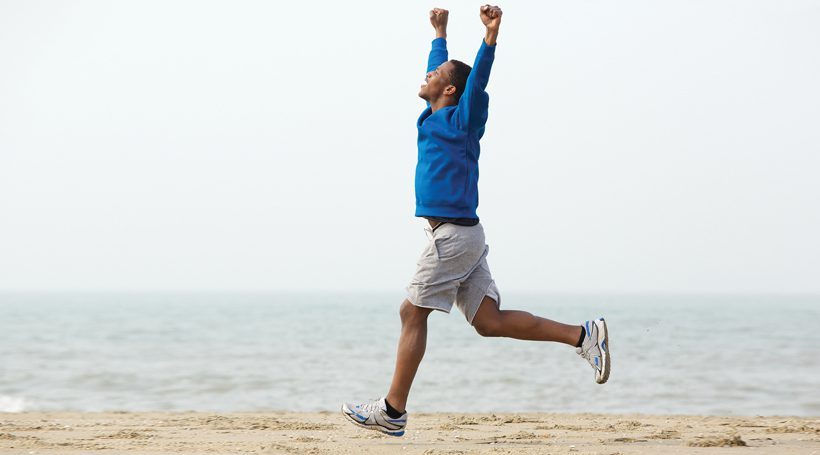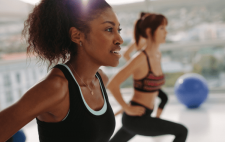Never has “going on a walk” been more popular than in the last 2 years. Especially during pandemic lockdowns – what else were people supposed to do? But even as the world opened back up, the idea stuck around. For so many people, it’s been a way to feel better, and even in these most unusual times, that’s nothing new.
“There’s a long history of humans running to feel better about themselves and their lives,” says Renee Hickman, MD, a family medicine provider at Capital Health. “There’s a significant mental and physical health component that goes hand-in-hand. Walking and running help with memory and mood, and increase the chemicals in your brain that make you feel happy. It has some of the same effects as taking medication to fight depression or anxiety.”
Some die-hard runners refer to this as “a runner’s high” – a sense of euphoria and ease that can come over someone while in the middle of a run.

Renee Hickman, MD
And of course, there are physical benefits as well, says Laura Ross, DO, an orthopedic surgeon and founder of the Ross Center for Orthopedics.
“Walking and running increase circulation, regulate blood sugar, lower cholesterol levels, burn calories, help you lose weight, decrease the risk of dementia and make it easier to fall asleep at night,” says Ross. “Overall, this type of exercise increases your sense of wellbeing.”
Of course, you won’t get those benefits on the first jaunt around the neighborhood. Doctors recommend 30 minutes a day of vigorous exercise – which means a stroll won’t cut it.
“It’s important to distinguish that when we talk about walking as exercise, we mean vigorous walking,” says Hickman. “The minimum pace you should be walking is 2 miles per hour.”
You can get all these benefits from walking and running – even if it may not seem like it right off the bat.
“A lot of walkers feel like they don’t get as many benefits as runners,” says Ross. “Regarding weight loss and caloric burn, you burn the same calories in the same distance, it just takes twice as long to walk.

Laura Ross, DO
If you want to speed up the process without heading into a full-on jog, you can work incline walking and speed walking into the routine.
If you’re looking to start, doctors advise you to walk before you run – literally. Especially for people with a history of injury, it’s important to get started the right way.
“If you have had any knee, ankle, back or hip problems, you’ll want to talk to your doctor to make sure everything looks strong enough and is aligned for this type of exercise,” says Ross. “If it is, there are ways to get into it like a run/walk approach, where you walk, speed walk and run on intervals, so you can gradually build up your strength. If not, swimming is usually a great option because you get similar benefits without the added pressure on your joints.”
“When a runner overdoes it, it’s common to develop orthopedic conditions like runner’s knee, shin splints, IT band syndrome, Achilles tendonitis, stress fractures in the shins or hips,” she adds.
Running also puts more impact on your joints than walking. When you walk, there’s at least 1 foot on the ground. When you’re running, you’re airborne, so you come down on 1 foot and your body absorbs the impact of up to 3 times your body weight.
If you have a minor or mild ache or pain when you’re walking or running, like a cramp in your side or a little twinge to the knee, that may be nothing to worry about. But if you continue exercising and those issues don’t go away – or they get worse – it’s a sign to stop.
“Unfortunately, there’s this idea that you push through the pain when you’re exercising,” says Ross. “And while any good exercise might make you sore, there’s a difference between that and actual pain. Unfortunately, we see many instances where runners, especially distance runners, feel an ache or twinge and try to push through it. That’s when they end up hurting themselves, whereas if they had taken a few days off to rest and recover, the issue might resolve much more quickly.”
“If whatever you’re feeling doesn’t respond to resting and taking Tylenol, ibuprofen or icing it in a short period, then it’s time to see a professional,” she adds.
You can even get injuries while walking if you’re not careful. For distance walkers and people who do incline walking, shin splints and tendonitis in the legs are common.
But there are ways to prevent these injuries before you even hit the pavement. Stretching is always the first place to start, says Hickman. “You really want to stretch for 10 to 15 minutes before exercise,” she says. “Most people stretch for 15 seconds.”
And if you’re putting on 10-year-old sneakers, it’s time for an upgrade.
“You should be replacing your shoes every 6 months if you do 30 minutes per day or an average of 4 hours per week,” Hickman says. “If you’re walking for an hour every day, you should replace them every 3 months.”
The best way to get these benefits, says Hickman, is to make it a habit.
“I recommend scheduling exercise, just like you’d schedule anything important in your life, like a haircut or dental appointment,” says Hickman. “Start with something manageable, like taking a 10- to 15-minute walk after dinner. Then, build from there.”














